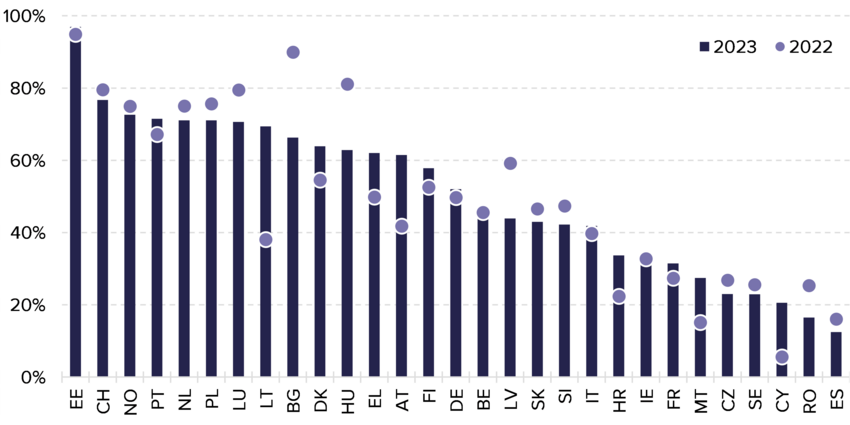3.13.1.2. Breakdown by country
As in previous years, considerable differences can be found with recognition rates for decisions issued at first instance across EU+ countries (see Figure 18). At the two extremes of the spectrum, almost all decisions issued by Estonia were positive (97%, the highest share ever), while just 12% of those in Spain and 16% of those in Romania granted some form of international protection. Other EU+ countries with high recognition rates included Switzerland (77%), Norway (73%), Portugal (72%, a record high), Poland, the Netherlands and Luxembourg (71% each).
The variation across EU+ countries can be partially explained by the citizenships dominating the caseload. For example, Estonia had a high recognition rate because almost all decisions were issued to Ukrainians, whereas the low rate in Romania was largely attributable to the prominence of nationals of Bangladesh. Nonetheless, the complexity of an asylum application and its examination cannot be reduced to a single measure such as the nationality of the applicant. Differences in the underlying profile of the applicant, national jurisprudence and policies, and the application of certain legal concepts also come into play and can result in different recognition rates.
Great variation is found in recognition rates across EU+ countries
Figure 18. Recognition rates across EU+ countries, 2023 compared to 2022

Source: EUAA EPS data as of 1 February 2024.
As seen in the past, recognition rates for applicants from the same country of origin sometimes differed significantly across EU+ countries. When considering the Top 10 citizenships in 2023,xxxvii the differences were evident in most cases.xxxviii For example for Afghans, recognition rates ranged between 34% in Belgium and 100% in Italy, while for Venezuelans, they spanned from 0% in Spain and 4% in Germany to 99% in Italy. While these discrepancies may partly reflect several objective factors that can lead to variations in recognition rates, their magnitude is largely the sign of a lack of convergence across EU+ countries.

